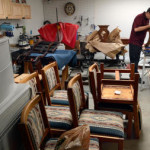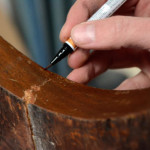Furniture Medic by Bespoke Restoration was featured in the Albuquerque Journal on Sunday December 13th.
Click here to see the full link: http://www.abqjournal.com/690518/biz/furniture.html
Furniture TLC: Fine wood pieces needs a little extra care in New Mexico’s sunny, arid climate
By Rosalie Rayburn / Journal Staff Writer
ALBUQUERQUE, N.M. — Just like your own skin, New Mexico’s fierce bright sun and arid high desert climate will leave your fine wood furniture craving moisture.
The state’s dry air and extreme temperature swings can cause tables, chairs and chests to shrink, warp and crack, especially pieces manufactured in tropical Asian locations or those used to more humid parts of the U.S.
Luckily, furniture experts can recommend ways to help ward off those unsightly blemishes. And the furniture world has its own equivalents to those anti-wrinkle creams that are designed to revive the youthful bloom of your sun-damaged skin.
Furniture restorer Mark Ryan of Furniture Medic by Bespoke Restoration sees a lot of problems like wood surfaces that look like alligator skin, poorly glued joints and joints that become loose, and splits and cracks in wood that has been exposed to the dry climate.
He also sees a lot of pieces that have been marred by white rings or dark stain marks in the finish.
Recommendations from furniture experts:
• Use a humidifier, especially in winter.
• Dust regularly and keep out of direct sunlight.
• Avoid placing furniture near a direct heat source.
• Use covers, coasters and pads to protect wood finish from heat or wet surfaces.
Prevention is the best approach, he said.
“Once wood splits you can’t put it back together. You have to fill the spot and it can always split further,” said Ryan.
That means keeping that nice dining table regularly dusted, protected from water spills and out of direct sunlight, which will fade the color, he said.
Ryan recommends investing in a humidifier. Winter time can be the hardest on furniture because homeowners turn on heating systems that rob humidity from the already arid air.
While summer brings high temperatures, the swamp cooler systems traditionally used to cool New Mexico homes can help put moisture in the indoor environment, he said.
The ideal humidity for any piece of furniture, according to the website of Los Angeles-based antique furniture dealer Lee Stanton, is between 50 percent and 55 percent.
A few other recommendations from Ryan and other experts: Avoid placing furniture near a direct heat source and use glass covers, cork or felt-bottomed coasters, trivets or natural-fiber tablecloths and pads to protect the wood finish from heat or wet surfaces.
Ryan is not a big fan of using furniture polish regularly, especially if the product contains silicone or petroleum distillates. He said they can damage the surface of the furniture over time. He prefers regular dusting with a soft, clean, lint-free microfiber cloth, chamois or cotton T-shirt.
If a piece has been neglected and there is a buildup of dust and grime, Albuquerque-based custom furniture maker Chris Sandoval of Artisans of the Desert recommends using a small amount of Murphy’s Oil Soap on a damp cloth to clean it.
Curt Westbrook, store manager at Woodworker’s Supply in Albuquerque, said Howard’s Orange Oil can also be used to remove dirt, grease and wax buildup.
Mark Ryan with Furniture Medic is a furniture restorer works on a Lyra Table base for a client that was broken in move in his shop on Dec. 03, 2015. (Jim Thompson/Albuquerque Journal)
Mark Ryan with Furniture Medic is a furniture restorer works on a Lyra Table base for a client that was broken in move in his shop on Dec. 03, 2015. (Jim Thompson/Albuquerque Journal)
“This will remove them without damaging the finish,” Westbrook said.
After cleaning, Sandoval recommends letting the surface dry for a day then rubbing lightly with a piece of super fine grade #0000 steel wool in the direction of the grain.
Howard’s Restor-A-Finish or Feed-N-Wax can be used to help restore the original color and luster to the finish.
Sandoval and Stanton favor using a paste wax polish once a year, twice if it’s a heavily used item. Sandoval said it’s important to follow the instructions provided. Choose a wax that is close to the color of the furniture item.
Prepare the surface by rubbing lightly with super fine grade #0000 steel wool and work in the direction of the grain.
Use a super-fine Scotch Brite pad to spread the paste evenly, working with the wood grain. Let wax set for not more than 20 minutes, then use a clean Scotch Brite pad to remove excess wax, Sandoval said.
Furniture restorer Mark Ryan does some precision repair work on the base of a client’s Lyra style table. (Jim Thompson/Albuquerque Journal)
Furniture restorer Mark Ryan does some precision repair work on the base of a client’s Lyra style table. (Jim Thompson/Albuquerque Journal)
Use a soft lint-free cloth to buff the surface lightly until it feels smooth.
Sandoval uses Liberon’s paste. Westbrook said other waxes such as J.E. Moser’s and Briwax are also suitable. Westbrook warned that most waxes contain solvents so it is important to work in a well-ventilated area and to wear gloves and a mask when applying the products.
Clapham’s Beeswax Salad Bowl Finish is solvent free and also safe to use on wooden kitchen ware, Westbrook said.
It’s important to remember that cloths used in these processes are at risk of spontaneous combustion. Sandoval said they should be allowed to dry completely then either discarded or washed.
- jt120315j/a sec/jim thompson/Mark Ryan with Furniture Medic is a furniture restorer looks over a table leg that he needs to repair. Thursday, Dec. 03, 2015.(Jim Thompson/Albuquerque Journal.)
- jt120315l/a sec/jim thompson/Mark Ryan with Furniture Medic is a furniture restorer works on a Lyra Table base for a client that was broken in move in his shop. Thursday, Dec. 03, 2015.(Jim Thompson/Albuquerque Journal.)
- jt120315k/a sec/jim thompson/Mark Ryan with Furniture Medic is a furniture restorer does some color touch up on a a Lyra Table base for a client that was broken in move. Thursday, Dec. 03, 2015.(Jim Thompson/Albuquerque Journal.)







